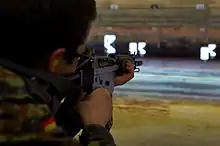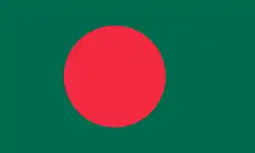FN FNC
The FNC (French: Fabrique Nationale Carabine) is a 5.56×45mm NATO rifle developed by the Belgian arms manufacturer FN Herstal and introduced in the late 1970s.
| FN FNC | |
|---|---|
 FNC rifle equipped with a bayonet. | |
| Type | Rifle |
| Place of origin | Belgium |
| Service history | |
| In service | 1979–present |
| Used by | See Users |
| Wars | Anti-guerrilla operations in Indonesia Sri Lankan Civil War Tuareg rebellion (1990–1995) Somali Civil War War in Afghanistan Conflict in the Niger Delta 2007 Lebanon conflict Libyan Civil War |
| Production history | |
| Designer | FN Herstal |
| Designed | 1975–1977 |
| Manufacturer | FN Herstal Carl Gustafs Stads Gevärsfaktori PT Pindad |
| Produced | 1979–2004 |
| Variants | See Variants |
| Specifications | |
| Mass | Rifle: 3.840 kg (8.47 lb) Carbine: 3.7 kg (8.2 lb) |
| Length | Rifle: 997 mm (39.3 in) stock extended / 766 mm (30.2 in) stock folded Carbine: 911 mm (35.9 in) stock extended / 667 mm (26.3 in) stock folded |
| Barrel length | Rifle: 449 mm (17.7 in) (rifle) Carbine: 363 mm (14.3 in) |
| Width | 70 mm (2.8 in) stock extended 75 mm (3.0 in) stock folded |
| Height | 238 mm (9.4 in) |
| Cartridge | 5.56×45mm NATO |
| Action | Gas-operated long-stroke piston, rotating bolt |
| Rate of fire | Approx. 700 rounds/min |
| Muzzle velocity | M193: 965 m/s (3,166 ft/s) SS109: 925 m/s (3,034.8 ft/s) |
| Effective firing range | 250–400 m sight adjustments |
| Maximum firing range | 450 m |
| Feed system | 30-round detachable STANAG box magazine (standard issue) or other STANAG magazines |
| Sights | Rear flip aperture, front post 513 mm (20.2 in) sight radius (standard rifle) |
Development

The FNC was developed between 1975–1977 for NATO standardization trials, as a less expensive alternative to the M16 rifle.[1][2] The rifle’s design is based on the FNC 76 prototype, which itself originated from the commercially unsuccessful FN CAL rifle.[1] This prototype was soon withdrawn from the NATO competition after performing poorly due to its rushed development. Later trials for the Swedish Armed Forces held between 1981–1982 using updated prototypes proved the utility and efficiency of the design, impressing both the Swedish military and Belgian Army staff back at home.[1] The FNC was finally adopted by the Belgian Armed Forces in 1989, as a service-wide replacement for the 7.62×51mm NATO FN FAL, after having been issued in small numbers to airborne infantry units for several years.[1]
Indonesia purchased approximately 10,000 rifles in 1982 for its air force, and later acquired a license to manufacture these rifles for all branches of the armed forces.[1] These are built by the Indonesian firm PT Pindad as the Pindad SS1 and Pindad SS2. A version of the FNC adapted for arctic conditions was adopted in 1986 as the standard service rifle of the Swedish Armed Forces (with the designation Ak 5) and is used in relatively small numbers by a number of other armies and police organizations.
Design details
Operating mechanism

The FNC is a selective fire weapon that uses a gas-operated long-stroke piston system and a rotating bolt locking mechanism equipped with two locking lugs that engage corresponding recesses in the barrel extension. The bolt is rotated and unlocked by the interaction of the bolt's cam pin with a camming guide contained in the bolt carrier. Overall, the mechanism strongly resembles that of Kalashnikov rifles, but adapted to more advanced design and production methods. The rear part of the cocking handle slot, cut in the upper receiver for the cocking handle, is covered by a spring-loaded cover which automatically opens by the handle when it goes back and automatically closes the opening when the cocking handle returns forward.[3]
Features

The spring extractor is located inside the bolt head, the ejector is fixed and riveted to the inside of the receiver housing. The FNC uses a 2-position gas valve, a hammer-type firing mechanism and a trigger with a fire selector switch that is simultaneously the manual safety, securing the weapon from accidental firing. The selector lever is located on the left side of the receiver and has 4 settings: "S" - weapon safe, "1" - single fire mode, "3" - 3-round burst, "A" - continuous (automatic) fire.
The FNC's barrel features a flash suppressor that is also used to launch NATO standard 22mm rifle grenades (only the standard rifle model has this capability). The gas block contains a gas valve setting that is used to isolate the gas system, providing an increased volume of propellant required to fire a rifle grenade. The sheet-metal gas valve switch when pulled upright, acts as a V-notch sight used for aiming the rifle grenades. The piston head and extension, as well as the gas port block, barrel bore and chamber, are hard-chrome plated to minimize the effects of propellant fouling.
The rifle feeds from 30-round steel magazines that are interchangeable with magazines from the American M16 rifle (STANAG 4179 compliant).[4] After the last round is fired, the bolt will remain closed as there is no provision for an automatic bolt hold open. However, the bolt handle can be manually worked to hold the bolt back. FNC magazines will function in AR-15/M16-type rifles but the follower will not hold the bolt open on the last round unless they have been replaced by an M16-type follower.[5]
The plastic-coated, lightweight alloy skeleton stock folds to the right side of the receiver. A fixed synthetic (polyamide) buttstock is also available.
The upper receiver is made from stamped steel, the lower receiver, along with magazine housing, is made from aluminum alloy.
Sights
The rifle has a flip-type L-shaped windage-adjustable rear sight with two apertures with settings for 250 and 400 m, while the front sight post is adjustable for elevation. Optics such as the Hensoldt 4× telescopic sight can be attached with the use of a receiver-mounted adapter.
Accessories
Standard equipment supplied with the FNC includes a spike bayonet or a variant of the American M7 blade bayonet (with the use of a lug adapter) and a sling. The rifle can be deployed with a barrel mounted bipod and blank-firing adaptor.
Variants
The FNC is produced in two primary configurations: a standard rifle and short (carbine) length. The "Standard" Model 2000 rifle and the "Short" Model 7000 carbine are equipped with barrels with 6 right-hand grooves and a 178 mm (1:7 in) rifling twist rate used to stabilize the longer and heavier Belgian SS109 bullet. The Model 0000 rifle and Model 6000 carbine use a slower 305 mm (1:12 in) twist rate for the shorter and lighter American M193 bullet.
Fabrique Nationale also offers semi-automatic-only Law Enforcement carbine versions: the Model 7030 with a 178 mm (1:7 in) rifling twist and the Model 6040 with a 305 mm (1:12 in) twist rate. These single-fire carbines feature a 410 mm (16.1 in) barrel and are also capable of firing rifle grenades and mounting a bayonet.
Sweden

The Swedish service rifle built by Bofors Ordnance (currently BAE Systems Bofors) is a modernized Model 2000 rifle without the 3-round burst fire control setting. It was accepted into service in 1986 as the Ak 5 after extensive trials and receiving several modifications and replaced the 7.62mm Ak 4 (a licensed version of the Heckler & Koch G3). Bofors has produced several variants of the basic Ak 5: the Ak 5B (equipped with a British 4× SUSAT optical sight but no mechanical iron sights),[6] the Ak 5C (a modular variant designed for compatibility with various accessories),[6] and the Ak 5D (a compact variant for vehicle crews and rangers).[7]
Indonesia

In Indonesia, a modified version of the FNC, produced under license as the Pindad SS1 with adaptations for jungle climate conditions, is used as the standard rifle of the Indonesian National Armed Forces. The Pindad SS2 is an updated version of the Pindad SS1. SS2 rifles have been phased into service since 2006 in the Indonesian military and police in order to gradually replace the SS1 rifles which were in service from the 1990s.
Users

 Bangladesh
Bangladesh.svg.png.webp) Belgium: Standard rifle of the Belgian Land Component; used in both the standard and carbine variants (called the FNC M2 and FNC M3 respectively).[8][9]
Belgium: Standard rifle of the Belgian Land Component; used in both the standard and carbine variants (called the FNC M2 and FNC M3 respectively).[8][9] Democratic Republic of Congo[10]
Democratic Republic of Congo[10]%253B_Flag_of_Serbia_and_Montenegro_(2003%E2%80%932006).svg.png.webp) Federal Republic of Yugoslavia: Used in unknown quantities by Special Operations Unit (Serbia)[11]
Federal Republic of Yugoslavia: Used in unknown quantities by Special Operations Unit (Serbia)[11] Indonesia: Purchased 10,000 rifles in 1982.[12] Now made under license as the Pindad SS1 and Pindad SS2.[13]
Indonesia: Purchased 10,000 rifles in 1982.[12] Now made under license as the Pindad SS1 and Pindad SS2.[13]
 Libya[14]
Libya[14] Mali: People's Movement for the Liberation of Azawad[15]
Mali: People's Movement for the Liberation of Azawad[15] Nigeria[10]
Nigeria[10] Sri Lanka[16]
Sri Lanka[16] Sweden: Accepted for use in 1986 and manufactured under license by Bofors Carl Gustaf as the Ak 5 (Automatkarbin 5).[17]
Sweden: Accepted for use in 1986 and manufactured under license by Bofors Carl Gustaf as the Ak 5 (Automatkarbin 5).[17] Timor Leste National Police of East Timor Used by special police units.[18]
Timor Leste National Police of East Timor Used by special police units.[18] Tonga: Standard service rifle of the Tongan military.[10][19]
Tonga: Standard service rifle of the Tongan military.[10][19] Venezuela[10]
Venezuela[10] El Salvador[10]
El Salvador[10] Vietnam[10]
Vietnam[10] Mongolia[10]
Mongolia[10]
See also
- List of assault rifles
- FN SCAR, multi-calibre and multi-role successor
References
- Walter, John: Rifles of the World (3rd ed.), page 123. Krause Publications, 2006.
- "Archived copy". Archived from the original on 2010-09-15. Retrieved 2010-09-20.CS1 maint: archived copy as title (link)
- Fabrique National FNC (FN-FNC). Archived 2016-03-04 at the Wayback Machine Retrieved on October 4, 2008.
- Kokalis, Peter G. (December 1985). "FNC; Belgium's Compact Carbine". Soldier of Fortune Magazine.
- Swedish military assault rifles 1945 - 1990, Ak4 and Ak 5. Retrieved on October 4, 2008.
- Modern Firearms' Bofor AK-5 Page. Retrieved on October 4, 2008.
- Marchington, James (2004). The Encyclopedia of Handheld Weapons. Lewis International, Inc. ISBN 1-930983-14-X.
- http://www.mil.be/armycomp/subject/index.asp?LAN=nl&FILE=&ID=1680&MENU=2183&PAGE=1
- Jones, Richard D. Jane's Infantry Weapons 2009/2010. Jane's Information Group; 35 edition (January 27, 2009). ISBN 978-0-7106-2869-5.
- http://www.crveneberetke.com/i-tvoje-ce-rane-neko-da-vida/. Missing or empty
|title=(help) - "Archived copy" (PDF). Archived from the original (PDF) on 2011-07-07. Retrieved 2010-06-18.CS1 maint: archived copy as title (link)
- Hogg, Ian (2002). Jane's Guns Recognition Guide. Jane's Information Group. ISBN 0-00-712760-X.
- Jenzen-Jones, N.R.; McCollum, Ian (April 2017). Small Arms Survey (ed.). Web Trafficking: Analysing the Online Trade of Small Arms and Light Weapons in Libya (PDF). Working Paper No. 26. p. 79.
- Small Arms Survey (2005). "Sourcing the Tools of War: Small Arms Supplies to Conflict Zones" (PDF). Small Arms Survey 2005: Weapons at War. Oxford University Press. p. 166. ISBN 978-0-19-928085-8.
- Smith, Chris (October 2003). In the Shadow of a Cease-fire: The Impacts of Small Arms Availability and Misuse in Sri Lanka (PDF). Occasional Paper No. 11. Small Arms Survey. p. 13.
- "Archived copy". Archived from the original on 2009-03-31. Retrieved 2009-03-21.CS1 maint: archived copy as title (link)
- Robert Muggah and Emile LeBrun, ed. (October 2010). Timor-Leste Armed Violence Assessment Final Report (PDF). Special Report No. 12. Small Arms Survey. p. 17. ISBN 978-2-940415-43-4.
- Capie, David (2004). Under the Gun: The Small Arms Challenge in the Pacific. Wellington: Victoria University Press. pp. 66–67. ISBN 978-0864734532.
Bibliography
External links
| Wikimedia Commons has media related to FNC. |